How to properly drain water from a washing machine: step-by-step guide and valuable tips
It is difficult to overestimate the role of washing machines in everyday life.Unfamiliar with fatigue, the units diligently perform some of the routine duties for their owners. Unfortunately, their mechanisms are prone to periodic failures. Therefore, it is better to find out in advance how to drain the water from the washing machine, so that in case of a breakdown you will know what to do.
We will tell you how to empty the washing machine tank if the programmed work cycle is not completed. The article we presented describes all acceptable, practice-tested methods. Our recommendations will help you properly prepare your equipment for restoration.
The content of the article:
When does it become necessary to drain the water?
Regardless of the brand of washing machine, its technical complexity and type of loading, the reasons for draining water from the working tank are absolutely the same. If we exaggerate the situation, then it can be described as an interrupted cycle that did not end with the drainage of water through the drain hose into the sewer as prescribed by the program, or a refusal to spin.
The reasons why the machine stops draining water can be roughly divided into the following groups:
- Blockages of internal components and channels. A fairly common case for washing equipment, caused by the standard separation of fibers, unraveling stitches, dilapidation and “dusting” of old fabric, and the ingress of small debris and foreign objects into the working parts of the equipment.
- Clogging of outlet channels. The reasons are similar to the prerequisites listed above. However, in this case, the “plugs” that prevent the water from draining have nothing to do with the washer’s mechanism. They are confined to the external drain hose and to adjacent parts of the sewer system.
- Technical issues. This category includes an extensive list of minor malfunctions and serious breakdowns. Anything can happen, from the burnout of the drain system pump winding to the manifestation of defects in the device transmitting commands.
There is another reason that has nothing to do with blockages or breakdowns - this is our carelessness. It is possible that the mode was simply chosen incorrectly. Suppose, due to forgetfulness, you did not switch the “gentle rinse” function after the previous session. If everything is so, then just stop and restart the machine.
You shouldn’t fight a complex technical violation with your own hands. Moreover, certified service centers that supervise products of certain brands often, after independent intervention, refuse to carry out repairs at all.
However, before you decide to disassemble the machine, you need to find out whether the reason for the refusal to drain is a clogged hose or sewer siphon.

It often happens that identifying the reason for the failure of washing equipment to drain water in the usual way is accompanied by its simultaneous elimination. It is clear that this happens when a standard blockage is removed.
You can deal with clogged filters located in front of the drain pump and clogged pipes installed next to the pump yourself, without resorting to the expensive services of repairmen.

Options for draining water from the machine
The need to drain the water from the washing tank occurs both for machines that have completed the programmed operation, and for those that have interrupted the cycle due to a breakdown.
Procedure for locking the door
If not all of the stages laid down by the command apparatus have been completed, then the hatches of the frontal models will still be blocked for 5–10 minutes. No need to pull the hatch holder and panic in vain. It will easily open after the period specified by the manufacturer of the unit.
If, nevertheless, the hatch does not open after the period specified by the manufacturer, then you should proceed as indicated in our recommended instructions. We recommend reading a very useful article that describes the process in detail.
It is better to cover the floor around the machine ahead of time with old bed linen, towels or similar hygroscopic things that perfectly and quickly absorb water and are also capable of holding it for a long time. In case of jamming, emergency unlocking means are used.
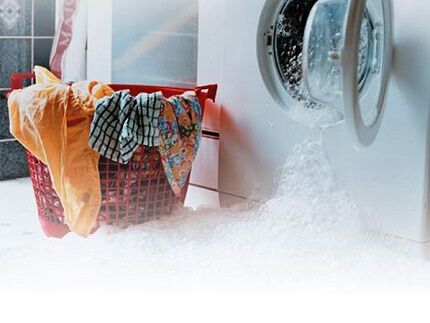
If, after opening the hatch, there is still water in the drum that can be scooped out with a plastic ladle or measuring cup, it is wiser to do just that.By getting rid of some of the water in this way, we will greatly simplify the task for ourselves.
You can empty almost all the water from top-loading washers, then drain the remaining water through a hose. The approach to frontal units is somewhat different. You can easily draw water from a drum if there is relatively little of it, i.e. the level does not reach the top edge of the bottom edge of the rubber seal.
If there is clearly more water in the frontal equipment than would be desirable for safe bailing out, it is better not to risk it and not to open the hatch right away.
It is advisable, without opening the front machine, to move it slightly away from the wall located behind it. Then you need to slightly “tilt” it back and carefully lean the top edge against the wall. Such movement of the container containing water will result in much less spillage on the floor.
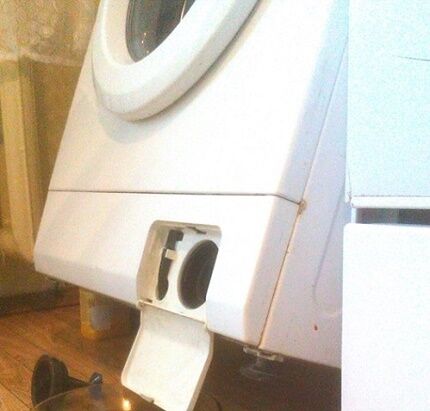
It is important to remember that all operations with the washing machine, regardless of their degree of complexity, must be performed by turning off the equipment and unplugging the plug from the socket. It is also necessary to shut off the tap water supply. Next, we will look at options for draining water from the washing machine tank.
Method #1 - Using an Emergency Hose
The possibility of the described situations occurring is provided for by a number of manufacturers. For example, in the line Samsung washing machines And Bosch equipment there are models with located next to washing machine filter an emergency hose through which the water-filled tank can be easily and simply emptied if necessary.
This device is located next to the drain system filter. To gain access to it, just open the decorative hatch located at the bottom of the front panel of the machine. It masks and protects components necessary for service.
To perform a drain:
- We remove the emergency hose from the niche, intended for its installation in an unused state.
- Install a flat container directly under the hatch or as close to him as possible.
- Remove the plug from the end of the hose, put it in a container and wait until all the water from the washing tank is completely drained.
If during the draining period this hose becomes clogged with something, it is better to carefully clean it immediately without disconnecting it from the machine.
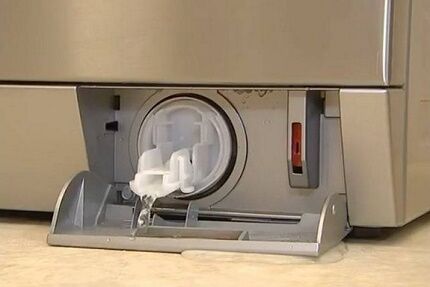
Method #2 - draining through a hole with a filter
This method is certainly one of the most labor-intensive and dirty. The drain hole to which the drainage hose is connected is located behind the decorative hatch described in the previous case. There is a filter installed inside the structure in front of the hose, which, according to operating rules, must be cleaned periodically.
In older models of washing machines, for example, Indesit brand models, the drain hole with the filter inserted above it is located quite low, it is quite difficult to place even an almost flat container under it.
Literally a plate with low sides is suitable as a collection container, but since... it will fill up extremely quickly, the hole will have to be closed frequently by tightly screwing the device with the filter grid. Then opening it again and closing it again takes a long time, but the drainage is complete and efficient.
The draining algorithm with filter removal is as follows:
- Opening the service cover – a small hatch located at the bottom of the machine.
- Carefully unscrew the plastic device with the filter grid, driving it counterclockwise with the screw included in the design. First, unscrew it quite a bit, about 10°. If it doesn’t give in, then we’ll help it with a screwdriver inserted into the groove on the screw.
- Drain the water. By loosening the sealed connection in the area of the drain assembly with the filter, we achieve a stream convenient for collecting water. Having filled the stored plate or cuvette, tighten the filter screw back so that no water flows out.
We continue this way until the machine is completely free of water. Having completed the draining, remove the device with the filter grid and clean it.
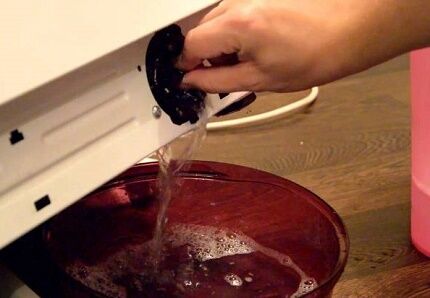
By the way, an uncleaned filter is a typical reason for stopping the machine without completing the assigned operations. If repeated frequently, this leads to excess load on the drain pump and to its almost inevitable failure.
Method #3 - using a drain hose
This is the simplest and most efficient way to empty the washing tank of water.True, it is suitable if the drain system filter and the drain hose itself are not clogged. Most often you have to do this if the pump that pushes water into the sewer breaks down.
According to the described method, the drain hose attached to the rear panel of the unit must be unscrewed from the hole intended for it and simply placed on a floor previously covered with rags, i.e. placed at the lowest level.
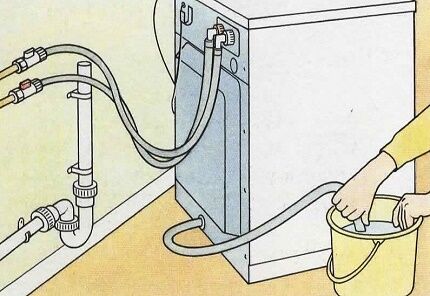
When water appears from the hose, you must immediately put it into a nearby container. Anything that spills past should be cleaned up immediately, without waiting for the indignant neighbors to arrive from the apartment located below you. After freeing the machine from water, you need to clean the drain hose filter and screw it back to the hole on the back of the device.
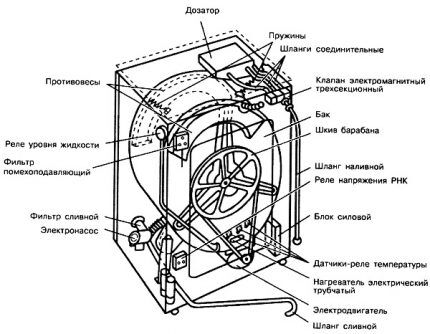
Please note that the method described in this example is not suitable for all machines. In a number of modifications from Siemens and Bosch, part of the drain channel is arranged in the form of a loop located inside the housing.
Thanks to the specified design solution, spontaneous drainage of water does not occur during operation, but it is also impossible to empty the tank using the described method.
In order not to waste your energy, it is better to look in advance at the passport and technical documentation attached to your home appliances. If the indicated design feature occurs, you must choose another method for draining.
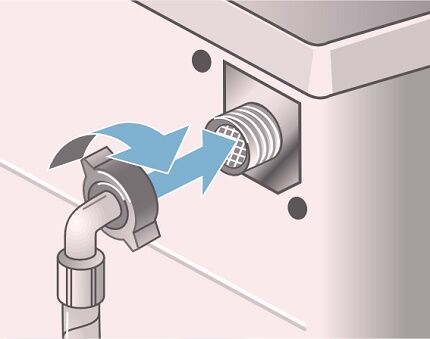
Method #4 - release through the drain pipe
The forced drain option through the pipe will require radical measures with machine disassembly.
You should not resort to this method without obvious reasons. It is suitable if all of the above methods did not result in the expected result. In addition, its implementation requires the application of male hands.
How to determine that the washing machine will need to be disassembled? A typical symptom is the complete absence of water in the drain hole after removing the filter device with mesh from it. This means that the internal channel that drains water to the drain hole is clogged.
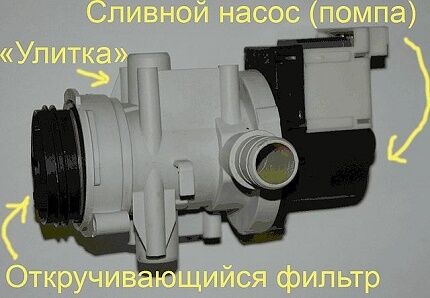
Sequence of actions in case of draining through the pipe:
- Remove the back or front panel of the washing machine, having previously unscrewed the fasteners and placed it in a suitable box or plastic cup.
- Finding the drain pipe. It is located under the tank, inside of which the drum rotates.
- We substitute any flat container under the area under the pipe, cover the area around with rags to instantly collect spilled water.
- Disconnect the clamp, with which the pipe is connected to the pump of the drainage system, dismantle the pipe, after which water should flow out in a stream. We quickly collect it and pour it into the sewer.
- Cleaning the pipe and the channel adjacent to it simply with a finger, pencil or similar object.
Having completed draining and cleaning the pipe, we install the machine parts in their proper place, tighten them with force, not forgetting that everything should be as tightly connected as possible.
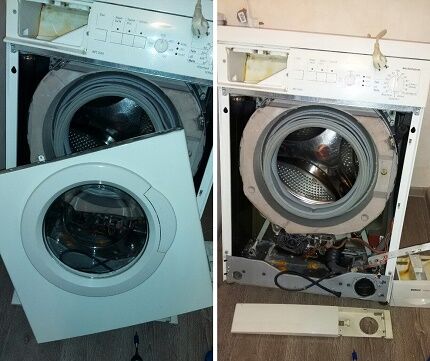
If, when cleaning, it turns out that the drain pump, carefully unscrew the pump cover and clean it of any contaminants that interfere with operation.
At the same time, we clean the threads of the drain pump and the inner surface of the housing. Checking how the impeller rotates. If it is loose, we assemble the system in the reverse order; if rotation is difficult, we clean the connection between the impeller wheel and the device motor.

Recommendations for housewives and home craftsmen
An impressive list of breakdowns and machine stops without completing the program can be easily prevented by following the simplest operating rules:
- Before loading items into the drum, remove all contents from pockets. Particularly harmful to the unit are coins, paper clips, earrings, rings, small luggage keys and similar metal objects.
- Check the tightness of sewing buttons and zippers. Before immersing clothes prepared for washing, zippers and buttons must be fastened.
- Use a brush to clean out dust and sand under lapels and in pockets..
- Remove hooks before washing curtains, with the help of which they are connected to the wheels of the curtain rod.
Do not forget that a washing unit is a complex technical device that requires careful handling.

We regularly clean the drain system filter at the intervals specified by the manufacturer.
If we load a lot of worn-out laundry into the drum, clean the filter after each wash.
Conclusions and useful video on the topic
Video #1. Draining water using an emergency hose and simply cleaning the filter:
Video #2. Demonstration of the process of removing water from the washing tank of an activator machine:
Video #3. Details about technologies for draining water from the machine:
Strict adherence to operating rules in most cases allows you to avoid situations requiring forced drainage of water from the tank. However, no one is completely safe from them..
Therefore, it is better to obtain information in advance about all possible methods used by independent home craftsmen.
Would you like to tell us about how you drained the water from the washing machine tank after a malfunction? Do you have useful information on the topic of the article, or would you like to share a method known only to you? Please write comments in the block below, ask questions and post photos.




It was very interesting to read. I often encounter the need to drain water. I put children's jackets or pillows or blankets, and when it comes time to spin, my machine refuses to work and gives an error. You have to open the door and drain all the water.Tell me, maybe I'm doing something wrong? In theory, the machine is designed for washing such things.
I can only assume that your machine is on strike because the weight of what is loaded into the machine is not properly centered. I had this happen: I was washing a pillow, and the machine tried to spin it ten times to spin it, shaking terribly, but still stopping and starting the process again. The problem was solved when I added a duvet cover. Apparently, then the weight was distributed evenly, and the machine was able to squeeze out.
There may be two reasons for the stop in your case - overload and imbalance of loaded items. Try washing things in parts, or distributing the laundry evenly in the drum. And for the future, indicate the error code that appears on the display.
Hello. Arisha, it’s a pity that you did not indicate the model of your washing machine and the error code. But we will try to find the reason together. Possible reasons, in my opinion, are:
1. Poor centering of the laundry.
2. There are problems with the drain pump. It’s very easy to check; you already know how to drain water; try sticking your finger into the drain hole to see if it’s clogged.
3. Level sensor malfunction.
4. Problems with the control module.
However, all these options can already be excluded, since you wrote that they are observed when washing “heavy” things, without mentioning light ones. Therefore, as already advised below, check the weight of items before loading so that it corresponds to the capabilities of the washing machine. Most likely, this is the problem, but I still have a very dubious possibility that you set the spin cycle on such a program manually.
Write down the model of the machine, the error code and tell me, did it previously wash without any complaints in this program?